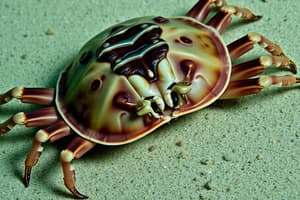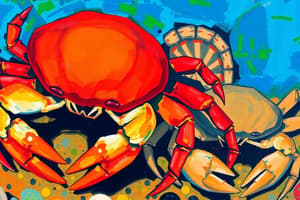Podcast
Questions and Answers
Horseshoe crab mating is primarily triggered by which environmental cue?
Horseshoe crab mating is primarily triggered by which environmental cue?
- Decreasing water temperature in autumn.
- High tides associated with new or full moons in spring and summer. (correct)
- Increased rainfall during monsoon season.
- Changes in ocean currents during winter months.
What is the role of pheromones in horseshoe crab reproduction?
What is the role of pheromones in horseshoe crab reproduction?
- To attract prey for the female horseshoe crab to consume before laying eggs.
- To mark the nesting sites for future generations of horseshoe crabs.
- To camouflage the female from predators during mating.
- To signal to male horseshoe crabs that a female is ready to mate. (correct)
How does fertilization typically occur in horseshoe crabs?
How does fertilization typically occur in horseshoe crabs?
- Females release eggs directly into the water to be fertilized by males.
- A male horseshoe crab grasps the female and fertilizes the eggs as she lays them in a nest. (correct)
- Males deposit sperm packets on the sand for females to collect.
- Horseshoe crabs fertilize internally after a prolonged courtship ritual.
Why do a majority of horseshoe crab eggs not survive to maturity?
Why do a majority of horseshoe crab eggs not survive to maturity?
Which of the following is a characteristic of horseshoe crab larvae immediately after hatching?
Which of the following is a characteristic of horseshoe crab larvae immediately after hatching?
What is the primary purpose of molting in juvenile horseshoe crabs?
What is the primary purpose of molting in juvenile horseshoe crabs?
At what stage of their life cycle do horseshoe crabs become reproductively mature and participate in mating?
At what stage of their life cycle do horseshoe crabs become reproductively mature and participate in mating?
Which characteristic distinguishes horseshoe crabs from true crabs?
Which characteristic distinguishes horseshoe crabs from true crabs?
What is the primary function of the telson in horseshoe crabs?
What is the primary function of the telson in horseshoe crabs?
How does the size of female horseshoe crabs compare to that of male horseshoe crabs?
How does the size of female horseshoe crabs compare to that of male horseshoe crabs?
Which part of the horseshoe crab's body houses the majority of its major organ systems?
Which part of the horseshoe crab's body houses the majority of its major organ systems?
If a scientist is studying the respiratory system of a horseshoe crab, which part of its body should they focus on?
If a scientist is studying the respiratory system of a horseshoe crab, which part of its body should they focus on?
What material primarily comprises the protective exoskeleton of a horseshoe crab?
What material primarily comprises the protective exoskeleton of a horseshoe crab?
Considering the horseshoe crab's evolutionary history, which extinct group of arthropods is most relevant for understanding its origins?
Considering the horseshoe crab's evolutionary history, which extinct group of arthropods is most relevant for understanding its origins?
A marine biologist discovers a new species of horseshoe crab. Based on current knowledge, in which geographic region is this new species most likely to be found?
A marine biologist discovers a new species of horseshoe crab. Based on current knowledge, in which geographic region is this new species most likely to be found?
Flashcards
Horseshoe crab maturity
Horseshoe crab maturity
Around 10 years.
Horseshoe crab mating season
Horseshoe crab mating season
Spring and early summer, during high tide under new/full moons.
Horseshoe crab pheromone
Horseshoe crab pheromone
A chemical signal released by the female to attract males.
Horseshoe crab egg laying
Horseshoe crab egg laying
Signup and view all the flashcards
Horseshoe crab life cycle stages
Horseshoe crab life cycle stages
Signup and view all the flashcards
Horseshoe crab larvae
Horseshoe crab larvae
Signup and view all the flashcards
Molting
Molting
Signup and view all the flashcards
Horseshoe Crab
Horseshoe Crab
Signup and view all the flashcards
Horseshoe Crab Habitat
Horseshoe Crab Habitat
Signup and view all the flashcards
Horseshoe Crab Body
Horseshoe Crab Body
Signup and view all the flashcards
Prosoma
Prosoma
Signup and view all the flashcards
Opisthosoma
Opisthosoma
Signup and view all the flashcards
Telson
Telson
Signup and view all the flashcards
Horseshoe Crab Size
Horseshoe Crab Size
Signup and view all the flashcards
Chitin
Chitin
Signup and view all the flashcards
Study Notes
- Horseshoe crabs are among the oldest living fossils on Earth
- They have been around for over 400 million years, predating dinosaurs
- They evolved around the same time as arthropods like the trilobite
- Despite the name, they are more closely related to spiders and scorpions than actual crabs
- There are four species of horseshoe crabs: one in North America and Mexico, and three in Southeast Asia
Appearance
- The body of a horseshoe crab resembles a horseshoe
- Their exterior is covered by a protective exoskeleton made of chitin
- They possess nine eyes and ten legs
- The body consists of three main parts: the prosoma, opisthosoma, and telson
The Prosoma
- It constitutes the head of the horseshoe crab
- It is the largest part of the body
- It houses the nervous and cardiovascular systems, protected by the exoskeleton
The Opisthosoma
- The middle part of the body
- It is triangular in shape and covered with protective spines
- Muscles and gills are located on the underside for movement and respiration
The Telson
- The final, long, and pointed portion of the body
- It is not dangerous and is used to flip the crab over
Size
- Female horseshoe crabs are larger than males
- Females measure about 46 to 48 centimeters in length
- Males measure about 36 to 38 centimeters in length
Reproduction
- Horseshoe crabs reach reproductive maturity at 10 years of age
- Male horseshoe crabs travel in groups to the shore in the spring and early summer to find mates
- Mating occurs during high tide under new or full moons
- The female releases a pheromone to signal her readiness to mate
- A single female is grasped by the male, which will then fertilize her eggs
Eggs
- After fertilization, the female digs nests and deposits the eggs
- Females create numerous nests during the mating season
- They lay tens of thousands of eggs each year
- Most eggs do not survive, serving as a food source for birds, reptiles, and fish
Life Cycle
- The horseshoe crab life cycle consists of the following stages: egg, larvae, juvenile, adult, and breeding adult
- The horseshoe crab has an average lifespan of over 20 years
Egg to Infancy
- Larval horseshoe crabs hatch approximately, two to four weeks after eggs are laid
- The larval form is a smaller version of the adult without the telson
- They live on tidal flats of shallow ocean waters for the first few years
Juveniles
- Horseshoe crabs undergo molting, shedding their exoskeleton to accommodate growth
- A horseshoe crab can experience up to 17 molts
- This takes around 10 years for the juvenile to reach adulthood
- Juveniles inhabit shallow ocean water, consuming the same foods as adults
Adults
- By ten years of age, horseshoe crabs reach reproductive maturity
- Adult horseshoe crabs return to sandy ocean beaches to restart the mating cycle
Studying That Suits You
Use AI to generate personalized quizzes and flashcards to suit your learning preferences.




